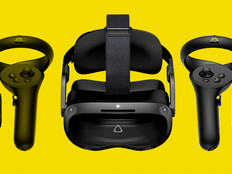Code RED: Really Easy Data Collectors
RED (Really Easy Data) is a simple, affordable, and fast solution to using probeware in your classroom. I've tried other competitors, and nothing I've seen can touch RED's ease of use.
On the ISTE show floor, I asked the RED representatives to explain what makes their solution better than their competitors'. One way RED simplifies data collection is by tethering each probe to its own handheld unit – no more searching for the right probe! At first, I thought this seemed like a bad idea: hard-wiring each probe to its own handheld collection device? Why not make the probes interchangeable?
But then I had an epiphany: A permanently tethered probe means that setup is easy and intuitive – just turn on the device and start collecting data!
I remember trying to learn how to use my last set of probes, and let me tell you: the learning curve for me, as well as my students, was time-consuming. With RED, I expect students will be able to spend more time collecting and analyzing data and less time figuring out how the devices work.
RED offers nine different sensors for some of the most popular activities in middle school science:
- Temperature;
- Light;
- Microphone;
- pH Meter;
- Photogate;
- Voltage/Current;
- Force;
- Gas Pressure; and
- Motion.
The solution's resistive touch-screen interface is completely icon-based, allowing students to use the device with gloves on (compared with other touch-screen solutions that rely on a capacitive pointer, such as a bare finger). It's also language-agnostic, which means that if you can read numbers and understand units of measurement, that's all the language you'll need. A "stop" button intuitively stops the data collecting, and a "record" button starts the recording.
Eager to test this out for myself, I picked up the Light sensor, turned the device on, pressed record and pointed it directly at a nearby light source. I could actually see the data live on the screen as it was being collected.
RED lets you analyze data quickly and easily by recording it to a standard USB flash drive. When data collection is complete, simply remove the drive from the handheld collector unit, insert the drive into your computer's USB port and open the .csv file in your application of choice. RED has developed A Microsoft Excel plugin specifically for this.
According to the company rep I talked to, Excel plugins don't require the same administrative rights that new software installations demand. So even if your school won't allow you to install software, you can install RED. Data files open instantly in Excel as completed graphs. And because most computers already have Excel installed, data is immediately ready for student analysis.
If you want to complete college-level data collection down to the thousandth of a degree with 15 probes attached, this may not be for you. But if you want to be up and running in minutes before your class begins and ensure that your students understand probeware intuitively, then look no further than RED. I could easily see students in upper elementary through high school having success with Really Easy Data Collectors.
For more ISTE coverage, get the full picture in the ISTE 2011 Wrap-up.
 Follow Buzz on Twitter: @buzzgarwood
Follow Buzz on Twitter: @buzzgarwood








